God's Garage Sale
by Annie Dixon
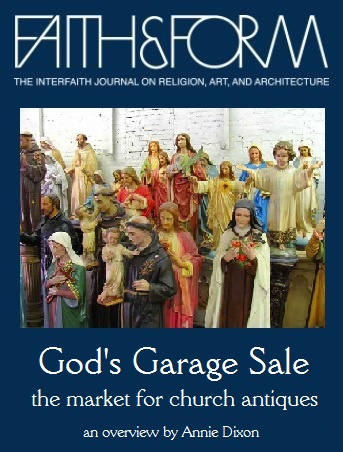 Something old is something new: items removed from traditional churches are being resurrected for use in contemporary worship spaces, via an evolving marketplace of church antiques. Something old is something new: items removed from traditional churches are being resurrected for use in contemporary worship spaces, via an evolving marketplace of church antiques.
Supply & Demand
The market for used church furnishings and appointments is a recent and predominantly Catholic phenomenon, supplied by the renovations following Vatican II and the closure and consolidation of parishes in the last few decades. During the same period, there was less demand for ecclesiastical artists and they sought new outlets elsewhere, leaving fewer church decorating companies and traditional craftsmen to create new works. Subsequently, a generation raised in the austere worship spaces now longs for ornate places of beauty, filled with objects of devotion and inspiration.
These demographics have converged to create the marketplace for vintage church goods, an unregulated bazaar of treasures and trinkets staffed by true believers and casual opportunists, knowledgeable antique dealers and amateur kitsch collectors, skilled restorers and savvy salvage merchants. They house their inventory in industrial warehouses and remote barns, funky storefronts and flashy online showcases, appealing to potential buyers with high hopes and low budgets who attempt to decode a pricing structure loosely based on material, design, age, condition, and a wild guess as to what the market will bear.
|
 |
|
|
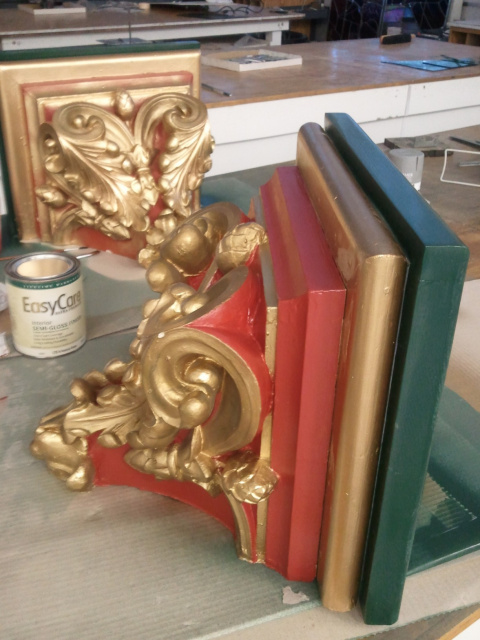 Bright Colors, Big Warehouse Bright Colors, Big Warehouse
Many pastors, parishioners, architects, and liturgical consultants are intrigued by the concept of reclaimed furnishings and assume they will get better value than they would by purchasing new items. While certainly possible, careful research and prudent planning can increase opportunities and minimize mistakes.
at left:
French statue brackets during restoration
Initial perusals of websites and first visits to vintage goods firms can be overwhelming; here is the ultimate exotic emporium, a divine display of discount devotional items, God’s garage sale! Items available range from the practical to the mysterious: pews and candlestands by the dozen –or the gross– are stacked high in warehouses; saints in assorted sizes are clustered in the inanimate purgatory of storerooms; shelves full of gold and silver vessels tilting this way and that hide their original luster under years of dings, dents, and dust; mosaic and stained glass panels languish in dark spaces, unable to glow, shine, sparkle, reflect, or otherwise let their light so shine before men. A sudden and overwhelming Christian duty to rescue and restore these precious pieces takes hold in the novice shopper. Besides: the prices are amazing! Or, are they?
Most clergy and parishioners charged with making major purchases for their churches actually have little or no point of reference regarding suppliers or pricing. Before embarking on the search for vintage items, one should be acquainted with the comparable market for current catalog and custom-made items; familiarity with the availability of certain materials, styles, finishes, and skilled craftsmanship, as well as cost and lead time will provide a baseline for determining the aesthetic and monetary value of vintage items.
The initial search for dealers and inventory can be accomplished online, using combinations of key words such as vintage / salvage / antique / used, church / religious / catholic / ecclesiastical, stations / statuary / altar / chalice and so on. Information on the availability or scarcity of certain items and the range of condition and pricing can be gleaned within these results by comparing specific terms among a number of sites. At the same time, the businesses can be placed within one of four categories: church goods suppliers with some vintage offerings, antique and architectural salvage dealers with some religious items, artisan studios and restoration services that maintain some inventory or provide a search service for specific items, and a few large firms focused solely on vintage church goods; each business model has its strengths, weaknesses, motivations, and biases, which can limit or expand the product line and services they offer, depending on the buyer’s perspective.
|
 |
|
|
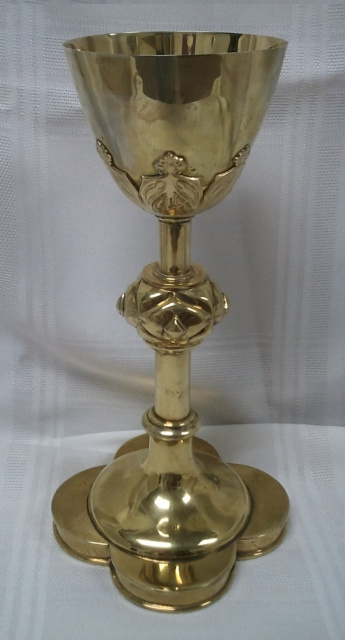 A Short History & Current Trends A Short History & Current Trends
In the United States, the field began to find its focus in the 1990's with practitioners coming from related disciplines; inventory here tends to concentrate on early 20th century plaster statuary, marble altars, mid-century metalware, and solid wood pews. In Europe, the move to modernize and secularize came about a bit earlier, with firms identifying the church market as far back as the 1970's, and specializing in marble, wood, and polychrome statuary spanning a few centuries. Architectural salvage companies in the British Isles started to focus on ecclesiastical elements at the same time, initially providing Anglican woodwork to commercial buyers who repurposed tracery, communion rails, and wainscoting for interior elements of pubs, restaurants, and hotel lobbies; they have since found some success in preserving and exporting such items to the American church clientele.
at right:
this simply elegant chalice revealed a Tiffany hallmark
under decades of tarnish
Recent economic conditions have driven prices down in many sectors and this niche market is no exception. Concurrently, increasing supply of inventory and number of dealers have brought competition and caution to this uncommon commerce which for years traded on the allure of the unique and meaningful to support arbitrary pricing and impulse shopping. And finally, many dioceses have become better stewards of redundant appointments, either handling the inventory and warehouse work internally, or contracting a church supply or design firm to do so, resulting in better recordkeeping, stricter guidelines on usage, and more reasonable and consistent prices than those previously set by commercial dealers.
|
 |
|
|
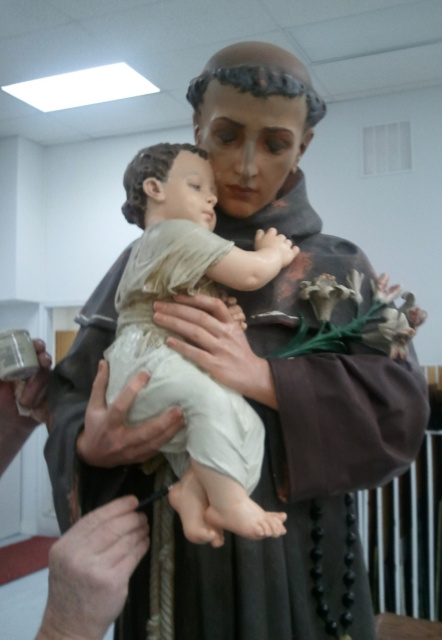 Selling & Shopping Selling & Shopping
Sellers should be realistic about perceived value, as most buyers expect bargains and even true treasures are being offered for sale to a charity. Willingness to consider all offers and to break up pairs or sets will invite more interest and produce quicker sales. Statues, metalware, and other individual pieces are the easiest to place; full sets and items that require specialized repair or a custom installation are a tougher sell. The total cost of a piece only starts with the purchase price; moving, storage, restoration, insurance, and installation costs will be deducted from the end value by a savvy buyer.
at left:
a vintage St. Anthony statue undergoes restoration
If possible, shopping should be done in person; if not, closeups from various angles should be requested. Although second-hand dealers cannot warranty craftsmanship or long-term durability, reputable ones will offer guarantees that composition and condition are as described. Astute shoppers will familiarize themselves with materials and styles, and be able to tell the difference between a period piece and a reproduction. They will recognize good design and craftsmanship –and the lack thereof, no matter the age of the item. And they will remember that beauty does not necessarily equal practicality: many of the closing churches were built by communities of recent immigrants, resulting in a great availability of obscure ethnic saint statues and stations with writing in foreign languages; incomplete sets of stations –in any language– may be beautiful but are not useful.
Buyers should concentrate on certain categories. Statues and crucifixes are often well preserved and easily relocated; cosmetic flaws can be patched and old-fashioned finishes covered with a tasteful monotone to preserve fine figure work, suitable for modern settings. Gold and sterling chalices and ciboria are valuable in the metals market but more precious on a spiritual level; they can be replated and restored at a bargain, keeping these sacred objects the service of the church. Tabernacles are easily disassembled, their metalwork revived and interiors relined, just as single furnishings, a pedestal or a presider’s chair, can be cleaned and refinished to preserve good quality materials and carving. These examples are easily transported and reinstalled.
below:
the restored St. Anthony statue
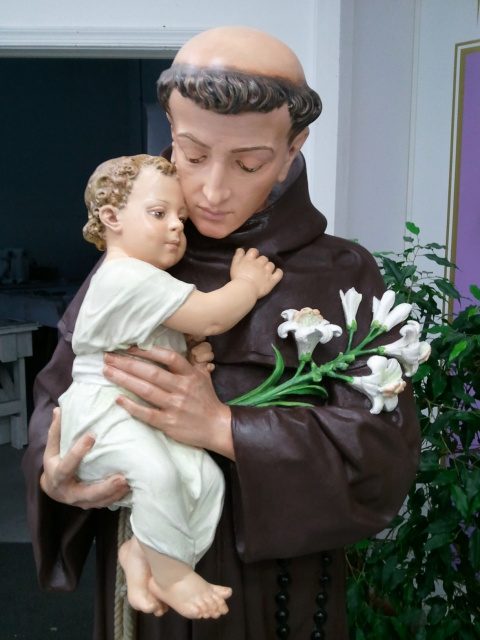 It may be tempting to consider more extensive projects but caution and creativity should guide purchases "with potential." Often, the cost to remove, repair, refinish and relocate large sets, heavy objects, or site-specific items will outweigh their final value. Dismantling pews weakens their structure and shortens their sustainable lifespan; installing new pews in the sanctuary for constant use and a few vintage ones in the narthex for Christmas and Easter overflow may offer an antique touch without the need for ongoing repairs. Heavy marble objects such as a high altar or a baldacchino require extensive labor and equipment to relocate; alternatively, dedicated or decorative parts, such as the mensa, a carved panel, or other architectural detail, may be worth moving and could be incorporated into newly crafted sanctuary furnishings. Many stained glass windows were designed with exquisite scenes surrounded by bric-a-brac backgrounds and borders; rather than repair and re-lead full windows and refit openings, the figurative vignettes could be removed, restored, and hung in frames in front of existing clear windows. These projects make good use of the best aspects of an article without wasting time or money to preserve its ordinary elements. It may be tempting to consider more extensive projects but caution and creativity should guide purchases "with potential." Often, the cost to remove, repair, refinish and relocate large sets, heavy objects, or site-specific items will outweigh their final value. Dismantling pews weakens their structure and shortens their sustainable lifespan; installing new pews in the sanctuary for constant use and a few vintage ones in the narthex for Christmas and Easter overflow may offer an antique touch without the need for ongoing repairs. Heavy marble objects such as a high altar or a baldacchino require extensive labor and equipment to relocate; alternatively, dedicated or decorative parts, such as the mensa, a carved panel, or other architectural detail, may be worth moving and could be incorporated into newly crafted sanctuary furnishings. Many stained glass windows were designed with exquisite scenes surrounded by bric-a-brac backgrounds and borders; rather than repair and re-lead full windows and refit openings, the figurative vignettes could be removed, restored, and hung in frames in front of existing clear windows. These projects make good use of the best aspects of an article without wasting time or money to preserve its ordinary elements.
|
 |
|
|
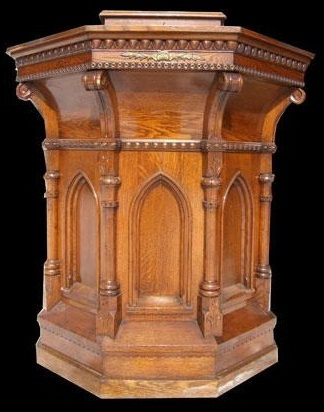 The Future of the Church’s Past The Future of the Church’s Past
The emergence of the church antique market coincided with a ready supply of used furnishings and appointments but as the volume and quality of inventory inevitably tapers off, prices will increase and buyers will search for alternatives. The size of the demand and whether it will be met with factory reproductions, a renewed support for ecclesiastical artisans, or a Vatican II redux will again be determined by a mix of demographics and economics within the context of the church’s values and vision. In the meantime, let us hope the pastors and parishioners of today will be good stewards of the true treasures reclaimed from yesterday.
at left: vintage ambo rescued & relocated by Dixon Studio
- - - - -
This article appeared in the national ecumenical magazine, Faith & Form, in 2012.
For more articles by Annie Dixon, click here.
|
 |
|
|
|
 |
|
DIXON STUDIO
a division of the Dixon Arts Guild, Inc.
323 N. Central Avenue; Staunton, VA 24401
800-619-1112
EMail: info@dixonstudio.com
Commonwealth of Virginia Class A Contractor License #2705135941A
Commonwealth of Virginia Class A Contractor
License #2705135941A
All website text & illustrations ©1999-2025 Dixon Arts Guild, Inc.
No content, image, or portion thereof may be copied,
reproduced or transmitted, in any format, in whole or in part
without express written permission from the Dixon Arts Guild.
|
|
|